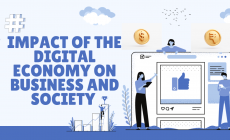-
UNION INTERIM BUDGET 2024-25 -
-
Are cryptocurrencies the future of the digital world economy -
-
Breaking Waves, Breaking News: Lakshadweep’s Recent Developments Explored -
-
The Impact of the Digital Economy on Business and Society -
-
Augmented Marketing: A Comprehensive Guide -
-
How To Strengthen Your Email Marketing Using AI -
-
How Artificial Intelligence and Digitization Are Transforming Our Lives -
-
What Data Science Tools do the Experts Recommend? -
-
Robotic Process Automation Will Transform Your Business? Check Here! -
-
Edge Computing: How it is Reshaping Cloud Infrastructure -
Augmented Marketing: A Comprehensive Guide
Augmented marketing is a cutting-edge marketing strategy that has been gaining traction in recent years. It involves using augmented reality (AR) technology to enhance the customer experience and create more engaging and interactive marketing campaigns. This blog will help you in attaining the best knowledge of augmented marketing.
What is Augmented Marketing?
Augmented marketing is a form of digital marketing that uses technology and physical media to interact with customers. This innovative form of marketing combines digital media with physical world elements such as augmented reality, image and video recognition, context-aware technologies, GPS, and virtual and interactive products. By utilizing elements of physical space, augmented marketing allows companies to create unique and interactive experiences that connect customers to their products and services.
Augmented marketing can be used in a variety of ways, such as creating interactive product demos, virtual try-on experiences, or 3D product visualizations. By allowing consumers to experience products in a more engaging and interactive way, augmented marketing can help to increase brand awareness, boost customer engagement, and drive sales.
Augmented marketing can be implemented using mobile apps, social media filters, or even physical installations such as kiosks or pop-up stores. As technology continues to evolve and become more accessible, augmented marketing is likely to become an increasingly important part of many companies marketing strategies.
Benefits of Augmented Marketing
Here are some of the benefits of augmented marketing:
1- Increased engagement: Augmented marketing allows brands to create more immersive and interactive experiences for customers, which can lead to higher engagement rates and better brand recall.
2- Personalization: By using data and analytics to understand customer behavior and preferences, brands can personalize their marketing messages and offers, which can lead to higher conversion rates and customer loyalty.
3- Improved customer experience: Augmented marketing can help create a more seamless and enjoyable customer experience, such as using AR to allow customers to visualize how products would look in their homes before making a purchase.
4- Increased brand awareness: Innovative and engaging augmented marketing campaigns can help brands stand out and increase their visibility in crowded markets.
5- Enhanced data collection: Augmented marketing campaigns can generate a wealth of data that can be used to refine marketing strategies and improve customer targeting.
Overall, augmented marketing can help brands create more meaningful and memorable interactions with customers, leading to better engagement, loyalty, and ultimately, increased revenue.
How to use Augmented Marketing?
Augmented marketing involves using technologies like augmented reality (AR), virtual reality (VR), and mixed reality (MR) to enhance the customer experience and drive sales.
Here are some steps you can follow to use augmented marketing effectively:
1- Identify your marketing goals: Before using augmented marketing, you need to define your marketing goals. What do you want to achieve? Is it to increase brand awareness, drive sales, or enhance customer experience? Understanding your goals will help you determine the type of technology to use, the target audience, and the message you want to convey.
2- Choose the right technology: There are different types of augmented marketing technologies, and you need to choose the right one for your business. AR is ideal for creating interactive experiences that overlay digital information onto the real world, while VR provides an immersive experience in a completely virtual environment. MR combines elements of AR and VR to create a seamless blend of the real and virtual world.
3- Create engaging content: To capture the attention of your target audience, you need to create engaging content. This could be anything from 3D product models to interactive games that incorporate your products or services. The key is to create content that is relevant, informative, and entertaining.
4- Promote your augmented marketing campaigns: Once you have created your content, you need to promote your augmented marketing campaigns. You can use social media, email marketing, or even offline advertising to reach your target audience. It’s essential to communicate the benefits of the technology and how it will enhance the customer experience.
5- Measure your results: Like any other marketing campaign, you need to measure your results. Use analytics tools to track the performance of your augmented marketing campaigns, such as the number of views, engagement rate, and sales conversion rate. Use this data to refine your strategy and improve your future campaigns.
By following these steps, you can use augmented marketing to create a unique and engaging experience for your customers while driving sales and enhancing your brand.
Examples of Augmented Marketing
Augmented marketing refers to the use of augmented reality (AR) technology in marketing to enhance the customer experience and increase engagement. Here are some examples of augmented marketing:
1- Virtual try-on: This involves using AR technology to enable customers to try on clothing or accessories virtually before making a purchase. Companies like Sephora and L’Oreal have implemented virtual try-on technology to enable customers to try on makeup products.
2- Interactive product demonstrations: AR can be used to create interactive product demonstrations that allow customers to explore products in a more engaging way. For example, Ikea’s AR app allows customers to visualize how furniture would look in their homes.
3- Gamification: AR technology can be used to create games and other interactive experiences that promote products or brands. For example, the Coca-Cola Magic app uses AR to turn Coke cans into mini-games.
4- Location-based experiences: AR can be used to create location-based experiences that promote products or services. For example, the Pokemon Go game encouraged players to visit real-world locations to capture Pokemon characters and promoted local businesses.
5- Augmented packaging: Companies can use AR technology to enhance their packaging with interactive content, such as videos, games, or 3D product models. For example, the wine company 19 Crimes uses AR to bring its labels to life with animated characters and stories.
These are just a few examples of how companies are using augmented marketing to enhance their marketing efforts and create more engaging customer experiences.
Tips for Successful Augmented Marketing
Augmented marketing, or the integration of augmented reality (AR) technology into marketing strategies, can provide a highly engaging and interactive experience for customers. Here are some tips for successful augmented marketing:
1- Define your objectives: Start by identifying what you want to achieve through augmented marketing. Is it to increase brand awareness, drive sales, or improve customer engagement? Knowing your objectives will help you determine the right approach and metrics to measure success.
2- Identify your target audience: Understand your target audience and their preferences. This will help you create AR experiences that are tailored to their needs and interests.
3- Develop compelling AR experiences: The success of your augmented marketing efforts largely depends on the quality of your AR experiences. Create experiences that are interactive, entertaining, and valuable to the user.
4- Make it easy to access: Make sure your AR experiences are easy to access and use. Consider using QR codes, links, or dedicated apps to make it easy for users to access your AR experiences.
5- Promote your AR experiences: Promote your AR experiences through social media, email campaigns, and other marketing channels to reach a wider audience.
6- Measure and analyze results: Track and analyze the performance of your augmented marketing campaigns. Use metrics such as engagement rate, click-through rate, and conversions to understand the impact of your AR experiences and optimize future campaigns.
7- Stay up-to-date: Keep up with the latest AR technologies and trends to ensure that your AR experiences are relevant and engaging for your audience.
By following these tips, you can create successful augmented marketing campaigns that drive engagement, improve brand awareness, and increase sales.
Conclusion
Augmented marketing is a promising technology that has the potential to revolutionize the way businesses interact with their customers. By using augmented reality, virtual reality, and other cutting-edge technologies, companies can create unique and immersive experiences that help them stand out in a crowded marketplace. Overall, augmented marketing is a rapidly evolving field that offers significant opportunities for brands to connect with their customers in new and exciting ways. By staying up-to-date with the latest trends and innovations in augmented marketing, businesses can stay ahead of the curve and deliver experiences that truly engage and delight their customers.
FAQs
Q- What is Augmented Marketing?
Ans- Augmented marketing is a form of digital marketing that uses technology and physical media to interact with customers.
Q- How will augmented marketing complement or replace traditional marketing methods?
Ans- Augmented marketing has the potential to enhance and complement traditional marketing methods by creating more engaging and personalized experiences for consumers.
Q- What is the future of augmented marketing and how will it evolve over time?
Ans- Augmented marketing is a rapidly evolving field that offers significant opportunities for brands to connect with their customers in new and exciting ways.
Q- What are some examples of companies using augmented marketing successfully?
Ans- Companies such as Nike, BMW, Buick and Microsoft are just some of the brands that have had success in incorporating this technique in their marketing activity.
Q- What technologies are used by augmented marketing to enhance customers’ experience?
Ans- Augmented marketing involves using technologies like augmented reality (AR), virtual reality (VR), and mixed reality (MR) to enhance the customer experience and drive sales.






























